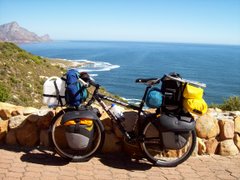








Feeling rather miserable after the theft of my photo´s, I made a hasty exit from Santa Cruz, heading West towards the Eastern slopes of the Andes (The Cordillera Oriental). I had a choice of 2 roads, and after consulting bus drivers at the terminal I took the Northern route (first I spoke to a group of taxi drivers at a pavement cafe, but at 9am they were too drunk to give decent directions). Although the road was busy, it was quite flat for the first few hundred kilometres. I stayed in some interesting places, and the simple rooms which I found there were dirt-cheap. Then the road tilted upwards towards the Altiplano (High Planes of Western Bolivia), and in less than 100 km I battled my way up from 300 m to 3 700 m. The road was supposedly paved, but it was in poor condition with gravel sections as well as cobblestones in places. At the end of climbing day 1 I was at around 2000 m and looking for a place to camp. I found a small roadside restaurant and upon enquiry I discovered that they had some rooms upstairs, as well as a hot shower (all for less than 3 Dollars). The following night I was up on the plains at Colomi, and from 3 700 m the road plummeted into a large dusty valley where I reached the city of Cochabamba more than 1000 m lower, 40 km later. At altitude the climate of the plains is rather desolate compared to the tropical atmosphere of the region down below. That lowland region is known for its variety of fruit (I bought tangerines and bananas a number of times at the roadside), as well as for production of coca (which they dry in front of their houses the same way they do cloves in Indonesia). The rural people live in stilted wooden houses (like in Laos), and they wash cars and clothes and themselves in the rivers (like in Africa). The women seem to have been cut from a square block of material and dress in pleated knee-length skirts and wear their hair in 2 long braids (the 2 in picture are actually quite skinny). The men are all scrawny and have a bulge of coca-leaf in their cheek. Up on the plains around Colomi the people have a smaller build, their houses are mostly made of mud bricks, and they have a somewhat Chinese look about them (in fact the landlady at the dump where I stayed in Colomi would not look at all out of place in parts of South-Western China). Cochabamba, where I am now, is the 3rd largest city in Bolivia, it is an interesting crazy town, but I have mixed feelings about the place. I arrived on Thursday afternoon and immediately went to the immigration office to extend my visa. I found there that they still follow a tedious paper trail, and I was instructed to fetch my visa on the Friday. On the Friday I discovered that some official had not yet signed my application, so I had to come back on Monday (this afternoon, and I hope it is ready). I also heard that about a month ago USA cyclists Eric and Amaya had booked into the same hotel where I´m staying, and while unpacking Eric had his fully laden bike stolen from the hotel courtyard (and I´m miserable over the loss of some photo´s!). Now I´m taking no chances, and I´ve not only locked my bike in my room but I´ve also chained it to the furniture. One of the things that I did get done here was to acquire a pair of reading glasses - now I look like somebody´s grandfather (the poor blighter), so perhaps it´s time for a shave again. If my visa is ready this afternoon then I´ll be climbing out of this valley again tomorrow, back up to the Altiplano where the air is thin and dry and cold. Daily distances cycled since my last post have been:- Buena Vista 109 km; Entre Rios 107 km; Chimore 73 km; Villa Tunari 37 km; Migalitu 64 km; Colomi 51 km; and Cochabamba 58 km. The total distance cycled in South America since November 2010 is 11 996 km. The total distance cycled on this journey so far is 78 483 km.









1 comment:
i like your beard - looks like u belong in an English country garden
PeterZ
Post a Comment